What's Happening
For the latest updates, check out our Instagram Feed:
Predator-Friendly Farming February 25 2024
Sustainability and environmental conscientiousness are important values for our family, and we extend that focus to our farm as well. When raising livestock that are technically prey in a wild ecosystem, we have to address how to handle predators that will be drawn to our animals. We feel we must coexist with the wildlife in and around our farm, including predators, instead of taking a lethal approach to predator control.
What does coexisting with predators look like? It depends on the livestock and the predator. For us, our predators are primarily skunks, raccoons, foxes (both red and gray), coyotes, and bears. There is a saying that where there are mule deer, there are mountain lions, but even with the large number of deer that enjoy our farm, we haven't seen any signs yet. Our three main lines of defense are closing our animals in at nighttime, Pinky our Livestock Guardian Dog (LGD), and electric fencing.
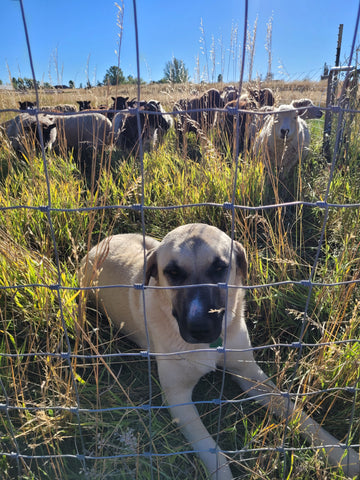
Pinky, our Anatolian Shepherd LGD with our grazing sheep.
Our ducks and chickens are our most vulnerable livestock. Closing them in their predator-proof coop at night prevents opportunistic predators like skunks, raccoons, and foxes from snatching them while they sleep. We prefer to have our poultry free-range in our pastures to diversify their diet, improve their health, and help with pests on the farm, but foxes are very smart and will prey on poultry during the day if the opportunity presents itself. Since we brought Pinky to our farm in the spring of 2023, we have been able to range our chickens and ducks without any losses. We're thrilled, as we had struggled with free-ranging our poultry because the foxes took every opportunity to nab a duck or chicken for their family of kits.
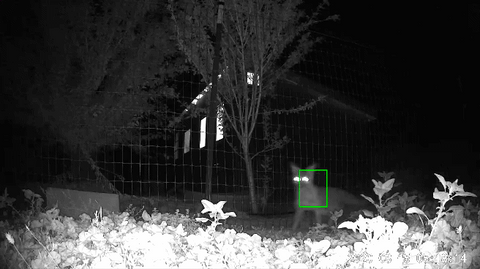
A gray fox in front of our "Fort Knox" chicken coop.
Our sheep have a secure barnyard where we pen them during the night. This protects them from all but the most determined large predators. Pinky's night pen is right between the ewes' and rams' pens to provide a protective presence for both areas. She also wards off foxes from getting too close to the chicken coop, although they know exactly where she can and cannot patrol.

A beautiful red fox keeps triggering our camera this winter, just beyond the limits of Pinky's night pen.
When grazing during the daytime hours, our sheep are most vulnerable to stray dogs, although we can't rule out coyotes. We use electric netting to create grazing paddocks and Pinky stays with them as well. This electric netting not only allows us to rotationally graze our pastures for better soil, forage, and animal health, but it also provides a solid line of defense against larger predators.
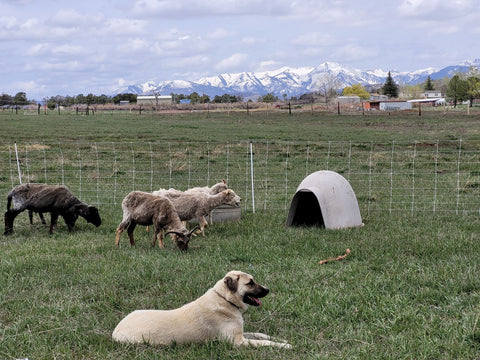
Pinky keeping watch while our sheep graze.
Interested in learning more about predator-friendly farming and farming with the wild? Check out the Wild Farm Alliance and Wildlife Friendly Enterprise Network.
- Kelsey
Preparing for the Santa Fe Wool Festival September 28 2023

In one week, I’ll be loading our trailer for the MAVWA Wool Festival in Santa Fe, NM. It’s been a difficult month for us, but we’re still excited to bring all our lovely wool products and more to our customers at the festival. We have lots of new colors, products, and variations of our offerings.
My mom, Pam, is having back problems that will prevent her from attending the festival this year. My kids and husband will be helping me run the booth while my mom and dad stay home. Pam will miss seeing you all, but this was the best decision for her health.
Our garden and orchard produced wonderfully this year, and I've also been busy harvesting and putting up a lot of food this month. On top of that and my mom's back problems, my daughter broke her foot. When it rains it pours, eh?
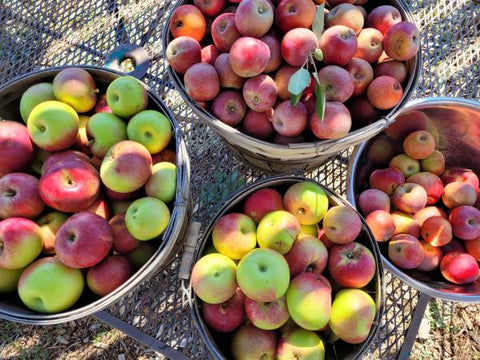
Look at all those apples!

Pear rings and pear leather in the dehydrator.

Abbey enduring the cast and crutches with fairly good spirits.
I’ve been dyeing up a storm this month. It’s always easiest to do most of the dyeing at once, while I have my tables and equipment set up on our back porch. It is such a lovely location to spend time—I get to overlook my garden and backyard orchard, enjoy the flowers, and listen to the birds. Dyeing is hard work, but a nice setting makes it enjoyable.

We have some new Shetland roving, Rambouillet combed top, and Rambouillet fine-weight yarn colorways. It’s always fulfilling to work with our lovely homegrown Shetland roving, and Rambouillet is such wonderful wool to work with—I’m excited to share the results with you. Don’t forget all our wool is grown in Colorado!
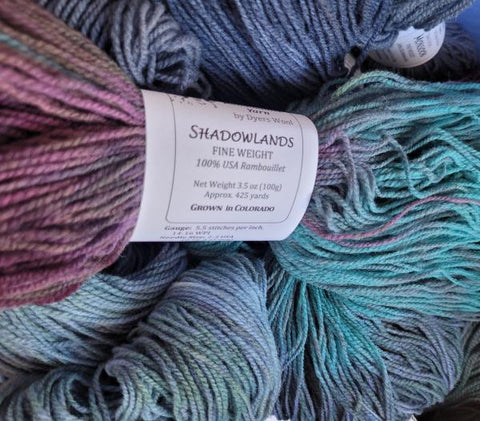

We are offering Navajo Churro this year in our discounted 8 oz roving balls, in addition to the Corriedale and Shetland. I also created multi-colored bundles of odds-and-ends roving that are perfect for any fiber artist looking for color options. These bundles contain a variety of roving thicknesses from all the wool we typically just add to our own personal stash—remnants, the thin roving that first comes off the machine, and others. At a price that can’t be beaten, we think our customers are going to love this new offering.

Don’t forget now is the time to purchase gifts for your friends and family. We will be offering numerous quantity discounts at the festival, so make sure you come by to see us!
- Kelsey

Oodles of Lambs! May 24 2015
Warning: the following article contains insane amounts of cuteness. View at your own risk.
We anxiously awaited the arrival of lambs this spring, schedule for the end of April, because we were using two new rams this year. Our new Navajo Churro ram is what's called a black and tan: he is solid black on most of his body, with a light tan belly and markings on his face. Our new Shetland ram is solid black.
We started the lambing season off with a bang when Claire, our moorit Shetland ewe, had two gorgeous black ewe lambs. Over the span of one week, the Reeder's half of Dyers Wool was done with lambing: three black ewes, one gray ewe, and two gray ram lambs. The Dyer's half of Dyers Wool didn't even start lambing until almost a week later, with the delivery of three lambs in one day: one white Shetland ram, one black Shetland ram, and one gorgeous black Churro ewe. A week later, the last ewe, a brown Churro, had healthy twin dark brown ewe lambs. What a great crop of lambs this year! Photo time!

Claire and her twin Shetland ewe lambs, Fiona and Frankie (top). Fiona relaxing with a full belly (bottom left). Claire gifted us with twin gray Shetland lambs, Fergus the ram and Fergie the ewe (bottom right).

Caelee gave us the only white Shetland lamb this year, a cute little ram (left). Bonnie, our moorit Shetland ewe, had a gorgeous black ram lamb (top right). Fergie and Fergus enjoying some pasture time (bottom right).

Our gorgeous black Churro ewe lamb, Flora.

Our two dark brown Churro ewe lambs, Fata and Fala, are so dark in color, you can't tell they're not black except in the brightest sunlight.

Every evening, the lambs go wild and we get to enjoy crazy lamb races!
Thanks for reading and enjoy the season!
- Kelsey
What's in a Name? - Red Mesa Heritage Blend Yarn April 18 2015
We've talked about the wool that went into our Red Mesa Heritage Blend Yarn, a 50/50 mix of Colorado-grown Corriedale and Tunis, but we haven't explained why we call it Red Mesa Heritage Blend. Well, there's a story there; it's a story of location and community. Red Mesa is a town just south of the main Dyers Wool farm, but it's also the name for the general area and surrounding community. The town is not what it used to be - it used to be a thriving dryland farming hub, but now it doesn't even have a post office. Yet there's something about the people here that makes it special. It's not the easiest place to live, as it's called the "Dryside" for the lack of abundant water, but somehow I think that makes the people stronger and kinder. They are good people, good neighbors, and good friends.

An old, abandoned beanery north of Red Mesa is a testament to the former thriving agriculture in the area.
We didn't just name the yarn after the area we farm. The name Red Mesa also invokes the flavor of our region. We are lucky to live and farm between the Colorado mountains to the north, and the Southwest desert to the south, and we enjoy visiting both places. In just a few hours drive, we can visit Chaco Culture National Historic Park in New Mexico, Cedar Mesa in Utah, or Monument Valley in Arizona/Utah. The canyons draw us, for both their beauty and the treasures they hold. My husband, Trent, and I are both archaeologists by training, and our love for our region's history takes us, and the family, on wandering adventures in remote canyons.

Chaco Canyon is one of our favorite places to visit in the winter.
The canyons and the desert vistas are so inspirational in their myriad colors. A desert sunset is a vibrant, awesome event, and we're blessed with more such vistas than we stop to appreciate. Desert dawn is one of my favorite times, and a summer monsoon storm drastically changes the desert landscape's colors and scents. Plants in the desert are wise, hardy creatures whose beauty is most visible in their ability to endure, yet when the conditions are right and the rains have come, they'll burst into bloom and amaze us with their vibrancy.

Our rainbow of desert-inspired colors.
There is inspiration also in the knowledge that our feet are not the first to walk these paths, and you can feel the echos of the past when you spot a broken pottery sherd alongside the trail, or your eye catches the faint outline of a pecked symbol in the cliff-face. There is history in this area, and deep mysteries. It is humbling.

Hand prints in Cedar Mesa. Could any of these hands be those of ancient spinners and weavers?
There's another story to our yarn - it was made possible by the support of our community of friends. The heritage Tunis wool is raised by our friend, John, who lives just up the road from the main Dyers Wool farm. Actually, he's more than just a friend - he's my former Wildland Fire Captain, from when I volunteered for the local fire department. This man exemplifies what I was talking about when I said the people in the Red Mesa area are amazing. I developed immense respect for him when serving with him on the fire department, and literally trust him with my life. I know if I ever needed help with ANYTHING at all, he would be there. He also has a great sense of humor.
The Corriedale wool came from our friend and fellow spinning guild member, Pam (there are too many Pams in the area that work with wool!), who lives on the eastern edge of our county. Her sheep enjoy lush pastures and great health at the base of the gorgeous HD Mountains. The fiber she produces is amazing - she is a former operator of a fiber mill, so she KNOWS her fiber!
Then there are a few other members of the local spinning guild who have really contributed to this yarn. Branding this yarn, from blend name to label to colorway names, would not have been possible without the copious advice and feedback from our wonderful French-bulldog-loving friend, Sheila (credit for the "Red Mesa" brand name goes to her husband). Thanks again, Sheila!

There were many renditions of the labels, with EXCELLENT feed back from Sheila, before we settled on these.
Lastly (but not least), are our friends who, when the yarn came back from the mill, we gave a skein of the new yarn to try out and play with. We needed feedback and they jumped into projects with the yarn almost immediately. They gave us great, and honest, responses, which helped us improve packaging and figure out the labeling, description, and advertising of the yarn. Most amazingly to me, two of them knit up their yarn into projects that they then GAVE back to us to be used as display pieces - thank you Susan and Carole!

Susan's gorgeous shawl in our Desert Rose sport weight yarn.

Carole's super fun Dr. Who-themed hat. (The Tardis is easily seen on the side, but there are also Daleks on the top!)
We really are blessed with an amazing community of neighbors, wool-growers, fellow fiber-artists, and friends. That is why the name of our community as the brand name of the yarn was so fitting. We see ourselves as more than just a retail fiber shop - we try to provide unique products with important stories of friendship, community, sustainability, and history, and encourage or support other fiber-producers however we can. I hope the inspiration we find in our community and the desert southwest inspires you in turn.
Thanks for reading and happy spring!
- Kelsey
It's Time to Spin November 04 2014
Fall is definitely here. Frost has put the garden to bed for the year, and there's snow on the mountains. We had a great year for tomatoes and peppers, which we stored for the winter by freezing, canning, and dehydrating.

I find myself gravitating toward my spinning wheel now, despite the fact I should be making inventory for the holiday season, cleaning the always-dirty house, or doing some other tangibly productive activity. Going back to my wheel and spinning is such a soothing activity in light of how busy we have been. I always look forward to winter days when there's a fire in the fireplace, snow flurries outside, and I can sit down and do some spinning. My husband laughingly says Sundays are a good day for me to spin, because football is on TV and I wouldn't have the attention-span to sit and watch it with him if I weren't spinning. The sheep are all nice and snug in their warm fleeces - it is always amazing to see the frost on them early in the morning - and that makes my fingers itch to spin up some warm handspun for winter hats and gloves.

I've enjoyed working with some of our dark brown Corriedale roving, which spins up like a dream, but now I'm clearing off my bobbins for my true passion - our homegrown Shetland wool. I finished plying some of our shaela (charcoal) wool from last year (from Caprica, the dark ewe in the above photo). It is such an easy spin, and one of my favorite colors. This year's crop looks to be as nice as last year's.

I'm very conscious about the quality of our Shetland roving, as I'm constantly evaluating our breeding program and many mills seem to have trouble processing Shetland fiber well. We've had it come back from the mill with noils, which could be on the mill's end from over-carding or -washing, or on our end from wool quality or biological issues (mites etc.). Additionally, our Shetlands do experience a "rise" of their wool, which is a historic trait of the breed that allowed Shetland shepherds to "roo," or pull/comb out, their sheep's wool instead of shearing. If we don't time shearing just right, we can get a natural break in the wool before or after shearing. Then there's always the vegetable matter, or VM, issue in roving as we don't coat our animals. Some fleeces just seem to attract VM, and the silly ram lambs sit in their hay while eating! It's enough to drive a shepherd mad!

With the limited number of Shetland sheep we have, and the small fleece sizes, we use a small mill who is willing to do small batches of each color for us, but small mills just don't have the capabilities of the larger ones. With all these concerns, it's always nice to evaluate the wool through spinning, even though we've gotten very good at judging the wool quality when we open up the shipping boxes fresh back from the mill. Anything that doesn't meet our quality standards is relegated to felting, woven roving pot holders, or pillow stuffing, although we do expect fellow spinners and fiber artists to understand our roving did come from a live farm animal and is not combed top. (On the subject of combed top, we feel that would be a disservice to Shetland fiber, as its beauty is in a woolen spin.)
I was a little leery when I sat down to spin some of our moorit (brown) Shetland roving from our ewes, Bonnie and Claire. I could tell it was nice and soft, and I knew the fiber staple was 4+ inches (I can't spin short fibers well), but there were some visible noils and VM. Not horrible, but when you only have two moorit ewes, it's tough to see your precious brown wool come back anything less than perfect. I started to spin, and a minute into it I was very, very happy; it was a great spin! The VM tended to fall out as I spun, and what didn't was easy to pick out, and the noils were very easy to pick out of the wool or even the yarn. That was a very different experience of noils than I've had in the past, and it hardly slowed me down. It spun as fast as the Corriedale roving, and soon I had a full bobbin.

Next I have my eye on the gorgeous gray roving from Cameron and Chloe. I had written off their fleeces as too coarse, but it came back from the mill as a lusciously soft, luminous gray shot through with darker (albeit, coarser) fibers. There are some noils visible in it, but I'm hoping they'll be as easy to handle as in the moorit roving. I'm watching the weather report, looking for the next nice spinning day - wind, snow, freezing temperatures, and maybe some football. It's time to spin.
Thanks for reading!
- Kelsey
Awards at the County Fair! August 15 2014 1 Comment
Last weekend was the La Plata County Fair, and my mom (Pam) and I entered a few things we had created during the year. We do it more just to support the fiber arts and local fiber groups, but appreciate getting feedback on our work at the same time. I was very proud of my mom for winning the Grand Champion ribbon for the weaving division with her handwoven pillow made from handspun, homegrown Navajo Churro wool. There were some amazing weaving entries this year, which is part of the reason I'm so proud!

Handwoven pillow made from handspun, homegrown Navajo Churro wool - natural and hand-dyed colors.

I've been spinning for seven years now, and was very excited to win the Reserve Grand Champion ribbon for the yarn division, along with the Best Use of Local Wool award!

The yarn was spun with fawn-colored Shetland lamb roving. This lamb (Edward) was born moorit/brown, and faded to nearly white by his first shearing. The Shetland colors are so fascinating! (Don't get me started on Shetland sheep genetics...)
Additionally, at the urging of my mother and my friend, Carole, I entered one of my stitch marker necklaces in the jewelry division of the fair. It won not only first-place in necklaces, but Judges' Choice award as well. Apparently, the judge was amazed at how nicely I do my loops. I am very flattered, and it's nice to have my hard work recognized; I work very hard on getting my loops just right and the edges tucked away because of their intended use as stitch markers.
Thanks for stopping by - take care! :-)
- Kelsey
Lambing is Done! May 18 2014
Lambing started May 1st with a double-header - one lamb in the morning and the next in the afternoon. To top it all off, I had a board meeting to attend that evening. It was a busy day. Two-and-a-half weeks later, and we were done with lambing. Yay!

This was Chloe's first lambing, and she did a great job. She had her little white ram lamb, Eddie, up and nursing in 20 minutes.


This handsome little guy is Ewan, out of Panda and Cameron. He is such a friendly little guy, and his pattern is so much fun! We expect he'll go gray, but he carries brown through his mother.

This was Claire's first lambing, too, and she didn't have as easy a time as her sister, Chloe. I had no inkling she was carrying twins, but sadly one of the twins didn't make it. The surviving twin, Elsa (Frozen the movie, anyone? our toddler named this one), is a gorgeous brown katmoget ewe lamb.

Gwen saved the best for last this lambing season. She has always twinned before, but this year she had a single ewe lamb, Eun (Gaelic for 'little bird'; pron. "En"). We've been waiting for a ewe lamb out of Gwen and McIntosh, and Eun did not disappoint. Her fleece is a soft, luminous white.

Nothing like a late-Spring snowfall. The lambs enjoyed it!
Take care!
- Kelsey
Happy Easter April 20 2014
Our Easter was festive with apple blossoms and homegrown and hand-dyed Easter eggs.

Our homegrown eggs - pink dyed with homegrown beets, yellow dyed with turmeric, and green/blue naturally colored.

Fingers crossed we get some apples this year despite the cold weather, especially from our Almata apple. Pink-skinned and -fleshed, it makes the most beautiful applesauce!
Happy Easter!
- Kelsey
